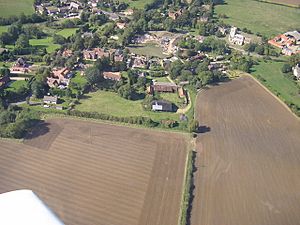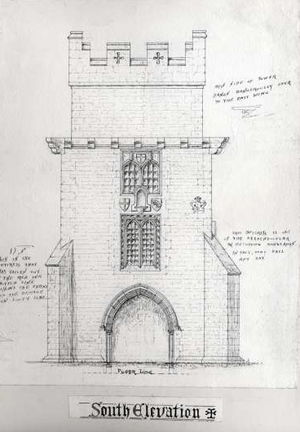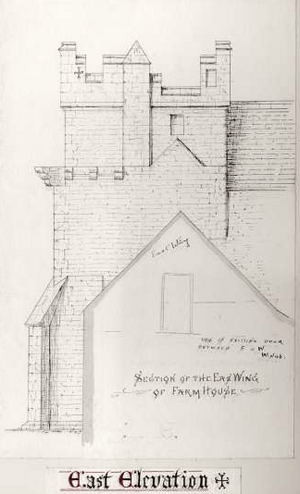Aslackby Preceptory facts for kids
Quick facts for kids Aslackby Preceptory |
|
|---|---|

Aslackby village – the preceptory was to the south-east of the church
|
|
| Location | The Temple Farm |
| OS grid reference | TF 08643032 |
| Founded | 1164 or earlier |
| Demolished | After 1536 and before 1892 |
|
Listed Building – Grade II
|
|
| Designated | 06-May-1952 |
| Reference no. | 1062758 |
| Lua error in Module:Location_map at line 420: attempt to index field 'wikibase' (a nil value). | |
Aslackby Preceptory was a special kind of religious house in Lincolnshire, England. It was located near Aslackby Church. For many years, part of its old buildings, like a tower and a cool underground room (called an undercroft), were used as part of a farmhouse. This farmhouse was later rebuilt. Today, you can still see a 15th-century window and a stone decoration (pinnacle) from the old preceptory in the garden.
Contents
History of Aslackby Preceptory
The Aslackby Preceptory was started by the Knights Templar. This was a powerful group of warrior monks. Records show it was founded in or before the year 1164. A man named Hubert de Rye gave the Templars the church of Aslackby and its chapel. This happened in 1164, a year when King Henry II of England and Archbishop Thomas had a disagreement.
After the Knights Templar group was closed down in the early 1300s, the Aslackby property was given to another place called Temple Bruer.
Who Were the Knights Templar?
The word preceptory was used for a community of the Knights Templar. These were brave knights who lived on one of their estates. A preceptor was in charge of the estate. The word also described the estate and its buildings.
Templar Church Design
The preceptory at Aslackby was officially founded in 1192. Not much of its original buildings are left today. But old descriptions and drawings tell us that its church looked a lot like the one at Temple Bruer Preceptory.
Templar churches often had a special design. They had a round main part (nave) and a rounded east end (apse). This design was meant to copy the Church of the Holy Sepulchre in Jerusalem. A famous example in England is the Temple Church in London. Later, towers were added to Templar churches, including the one at Aslackby around the year 1200.
In 1192, there was already a village here with a small castle. Part of the land was given to the Templars, who managed it from Aslackby.
The Knights Hospitaller
In 1808, John Moore wrote about Aslackby Temple. He mentioned that it was once a Preceptory for the Templars, possibly founded by John le Mareschel around the time of King Richard I. The Templars received land and the church before 1185. Later, the property was given to the Knights Hospitaller.
Moore described a large round church that was rebuilt as a farmhouse, still called "The Temple." He noted that a strong square tower remained. The lower part of the tower was a cellar with vaulted arches and shields carved into the stone. These shields showed symbols of important families.
When the Knights Templar group was officially ended in 1312, most of their property was given to another group called the Knights Hospitaller. The Templars' main job was to protect people traveling to Jerusalem. The Hospitallers also did this, but they also focused on providing places for travelers to stay.
Aslackby Under Hospitaller Control
For the Hospitallers, a similar type of estate was called a commandery. However, Aslackby was not run as a commandery. After 1312, the property was rented out. This meant the buildings at Aslackby lost their important religious use much earlier than most other monastic buildings in England. Most monasteries were used until the 1500s.
By 1539, the buildings at Aslackby were said to be in ruins. When the Hospitallers' houses in England were closed down around 1540-1541, the Aslackby lands were given to a nobleman, Lord Clinton.
Evidence of the Medieval Preceptory
In 1789, a historian named Richard Gough wrote about Aslackby. He suggested that the Preceptory might have started when John Le Marshall gave a main dwelling (messuage) in 1193. Gough also said that there was a "round church, now rebuilt as a farm house, and still called the Temple." This suggests that people in the area remembered a round church, similar to the one at Temple Bruer Preceptory. It might have been standing until the 1700s.
Visitors' Accounts
Soon after, in 1791, a diarist named John Byng visited Temple Farm. He wrote about a "turreted building" (a building with small towers). He was shown into a lower room, which was then a dairy. This room had cool stone arches with coats of arms carved in the middle. Byng also mentioned a large park with trees and deer around the house, which was destroyed about 80 years before his visit. Byng even drew a sketch of the tower, showing an arched doorway at ground level.
In 1808, John Moore, a historian, wrote about Aslackby Preceptory in a magazine called The Gentleman's Magazine. He promised to include an engraving of the Preceptory in a later book. While that specific engraving wasn't published, another one of Aslackby village was made around 1835. This engraving showed Temple Farm and the Preceptory tower.
The Tower's Collapse
Towards the end of the 1800s, the tower's condition was worrying. The Society for the Protection of Ancient Buildings (SPAB) tried to get the owners to fix it. However, the tower was eventually taken down because it was thought to be too dangerous. Detailed drawings of the tower were made before it was demolished.
Some pieces of the old building were moved to a garden in Horbling. These pieces are likely the arch from the tower's lower floor. They are now at the Old Rectory in Horbling and are protected as a Grade II listed structure.
Other Templar Sites in Lincolnshire
- Bottesford, Lindsey. This was a smaller part of Willoughton.
- Temple Belwood, Belton, North Lincolnshire
- Grantham Angel and Royal
- Gainsborough, Lincolnshire
- Great Limber, Lindsey
- Horkstow, Lindsey. Also a smaller part of Willoughton.
- Mere, Branston and Mere. Likely a farm (grange) of Willoughton.



